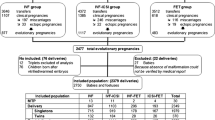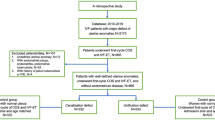Abstract
Purpose
The aim of this study was to provide a comprehensive follow-up of fetal and perinatal outcome and the incidence of congenital anomalies in babies born after fresh embryo transfers compared to those conceived spontaneously in infertile couples.
Methods
Retrospective comparative analysis of all clinical pregnancies from fresh cleavage-stage embryo transfer cycles (IVF and ICSI) compared with infertile patients who conceived spontaneously in the same time period (control). Congenital anomalies were classified following the European Surveillance of Congenital Anomalies (EUROCAT) classification.
Results
A total of 2414 assisted reproductive technology (ART) pregnancies were compared to 582 spontaneous conceptions in the control infertile group representing 2306 deliveries. No significant differences were found in pregnancy outcome between the two groups (delivery rate, abortion rate, ectopic pregnancies, medical abortions for fetal anomalies, single and twins mean gestational age, and weight at delivery). A significant difference (p < 0.001) was found in the twin (21.3 vs 2.3 %) and triplet rates (2.3 vs 0 %). A total of 2351 babies were delivered in the ART group and 449 in the control group. A total of 90 babies (3.8 %) were diagnosed with a major congenital anomaly in the ART group and 15 (3.3 %) in the control group (p = ns). The overall rate of major congenital anomalies (105/2800) in ART and spontaneous pregnancies in infertile couples was significantly higher when compared to the EUROCAT 2.0 versus 3.75 % (p = 0.0002).
Discussion
Babies born after ART treatments and from spontaneous conception in infertile couples had rates of congenital anomalies higher than those recorded by the EUROCAT. However, the rates of anomalies were not different within the infertile population whether conceived by ART or spontaneously. These data suggest that the diagnosis of infertility in itself is the common denominator for the increase in the rates of anomalies seen in both ART and spontaneous conceptions.
Similar content being viewed by others
References
Jain T, Gupta RS. Trends in the use of intracytoplasmic sperm injection in the United States. N Engl J Med. 2007;357:251–7.
Declercq E, Luke B, Belanoff C, Cabral H, Diop H, Gopal D, et al. Perinatal outcomes associated with assisted reproductive technology: the Massachusetts Outcomes Study of Assisted Reproductive Technologies (MOSART). Fertil Steril. 2015;103:888–95.
Sullivan EA, Zegers-Hochschild F, Mansour R, Ishihara O, de Mouzon J, Nygren KG, et al. International Committee for Monitoring Assisted Reproductive Technologies (ICMART) world report: assisted reproductive technology 2004. Hum Reprod. 2013;28:1375–90.
Registro Nazionale di Procreazione Medicalmente Assistita. Relazione del Ministro della Salute al Parlamento sullo stato di attuazione della legge contenente norme in materia di procreazione Medicalmente Assistita (Legge 19 Febbraio 2004, N 40, articolo 5). In 2015.
Births in Great Britain resulting from assisted conception, 1978–87. MRC working party on children conceived by in vitro fertilisation. BMJ 1990;300:1229–33.
Dhont M, De Sutter P, Ruyssinck G, Martens G, Bekaert A. Perinatal outcome of pregnancies after assisted reproduction: a case–control study. Am J Obstet Gynecol. 1999;181:688–95.
French National IVF Registry: analysis of 1986 to 1990 data. FIVNAT (French In Vitro National). Fertil Steril 1993;59:587–95.
Reefhuis J, Honein MA, Schieve LA, Correa A, Hobbs CA, Rasmussen SA, et al. Assisted reproductive technology and major structural birth defects in the United States. Hum Reprod. 2009;24:360–6.
Boulet SL, Schieve LA, Nannini A, Ferre C, Devine O, Cohen B, et al. Perinatal outcomes of twin births conceived using assisted reproduction technology: a population-based study. Hum Reprod. 2008;23:1941–8.
Schieve LA, Rasmussen SA, Reefhuis J. Risk of birth defects among children conceived with assisted reproductive technology: providing an epidemiologic context to the data. Fertil Steril. 2005;84:1320–4. discussion 7.
Schieve LA, Rasmussen SA, Buck GM, Schendel DE, Reynolds MA, Wright VC. Are children born after assisted reproductive technology at increased risk for adverse health outcomes? Obstet Gynecol. 2004;103:1154–63.
Schieve LA, Meikle SF, Ferre C, Peterson HB, Jeng G, Wilcox LS. Low and very low birth weight in infants conceived with use of assisted reproductive technology. N Engl J Med. 2002;346:731–7.
Belva F, Henriet S, Van den Abbeel E, Camus M, Devroey P, Van der Elst J, et al. Neonatal outcome of 937 children born after transfer of cryopreserved embryos obtained by ICSI and IVF and comparison with outcome data of fresh ICSI and IVF cycles. Hum Reprod. 2008;23:2227–38.
Hansen M, Kurinczuk JJ, Milne E, de Klerk N, Bower C. Assisted reproductive technology and birth defects: a systematic review and meta-analysis. Hum Reprod Update. 2013;19:330–53.
Leunens L, Celestin-Westreich S, Bonduelle M, Liebaers I, Ponjaert-Kristoffersen I. Follow-up of cognitive and motor development of 10-year-old singleton children born after ICSI compared with spontaneously conceived children. Hum Reprod. 2008;23:105–11.
Sutcliffe AG, Ludwig M. Outcome of assisted reproduction. Lancet. 2007;370:351–9.
Zegers-Hochschild F, Adamson GD, de Mouzon J, Ishihara O, Mansour R, Nygren K, et al. International Committee for Monitoring Assisted Reproductive Technology (ICMART) and the World Health Organization (WHO) revised glossary of ART terminology, 2009. Fertil Steril. 2009;92:1520–4.
Levi Setti PE, Albani E, Matteo M, Morenghi E, Zannoni E, Baggiani AM, et al. Five years (2004–2009) of a restrictive law-regulating ART in Italy significantly reduced delivery rate: analysis of 10,706 cycles. Hum Reprod. 2013;28:343–9.
Levi Setti PE, Albani E, Cesana A, Novara PV, Zannoni E, Baggiani AM, et al. Italian constitutional court modifications of a restrictive assisted reproduction technology law significantly improve pregnancy rate. Hum Reprod. 2011;26:376–81.
Garne E, Dolk H, Loane M, Boyd PA, EUROCAT. EUROCAT website data on prenatal detection rates of congenital anomalies. J Med Screen. 2010;17:97–8.
Group ECW. Birth defects and congenital health risks in children conceived through assisted reproduction technology (ART): a meeting report. J Assist Reprod Genet. 2014;31:947–58.
Database EWS. Access prevalence data/prevalence tables. In. Vol. 2014.
Jackson RA, Gibson KA, Wu YW, Croughan MS. Perinatal outcomes in singletons following in vitro fertilization: a meta-analysis. Obstet Gynecol. 2004;103:551–63.
Herbert DL, Lucke JC, Dobson AJ. Birth outcomes after spontaneous or assisted conception among infertile Australian women aged 28 to 36 years: a prospective, population-based study. Fertil Steril. 2012;97:630–8.
Sutcliffe AG, Taylor B, Saunders K, Thornton S, Lieberman BA, Grudzinskas JG. Outcome in the second year of life after in-vitro fertilisation by intracytoplasmic sperm injection: a UK case–control study. Lancet. 2001;357:2080–4.
Kissin DM, Kulkarni AD, Kushnir VA, Jamieson DJ, Group NASS. Number of embryos transferred after in vitro fertilization and good perinatal outcome. Obstet Gynecol. 2014;123:239–47.
Ercan CM, Kerimoglu OS, Sakinci M, Korkmaz C, Duru NK, Ergun A. Pregnancy outcomes in a university hospital after legal requirement for single-embryo transfer. Eur J Obstet Gynecol Reprod Biol. 2014;175:163–6.
Davies MJ, Moore VM, Willson KJ, Van Essen P, Priest K, Scott H, et al. Reproductive technologies and the risk of birth defects. N Engl J Med. 2012;366:1803–13.
Rimm AA, Katayama AC, Diaz M, Katayama KP. A meta-analysis of controlled studies comparing major malformation rates in IVF and ICSI infants with naturally conceived children. J Assist Reprod Genet. 2004;21:437–43.
Rimm AA, Katayama AC, Katayama KP. A meta-analysis of the impact of IVF and ICSI on major malformations after adjusting for the effect of subfertility. J Assist Reprod Genet. 2011;28:699–705.
Zhu JL, Basso O, Obel C, Bille C, Olsen J. Infertility, infertility treatment, and congenital malformations: Danish national birth cohort. BMJ. 2006;333:679.
Bonduelle M, Wennerholm UB, Loft A, Tarlatzis BC, Peters C, Henriet S, et al. A multi-centre cohort study of the physical health of 5-year-old children conceived after intracytoplasmic sperm injection, in vitro fertilization and natural conception. Hum Reprod. 2005;20:413–9.
Wen J, Jiang J, Ding C, Dai J, Liu Y, Xia Y, et al. Birth defects in children conceived by in vitro fertilization and intracytoplasmic sperm injection: a meta-analysis. Fertil Steril. 2012;97:1331–7. e1-4.
Yan J, Huang G, Sun Y, Zhao X, Chen S, Zou S, et al. Birth defects after assisted reproductive technologies in China: analysis of 15,405 offspring in seven centers (2004 to 2008). Fertil Steril. 2011;95:458–60.
Pinborg A, Wennerholm UB, Romundstad LB, Loft A, Aittomaki K, Söderström-Anttila V, et al. Why do singletons conceived after assisted reproduction technology have adverse perinatal outcome? Systematic review and meta-analysis. Hum Reprod Update. 2013;19:87–104.
Messerlian C, Platt RW, Tan SL, Gagnon R, Basso O. Low-technology assisted reproduction and the risk of preterm birth in a hospital-based cohort. Fertil Steril. 2015;103:81–8. e2.
Henningsen AK, Pinborg A, Lidegaard Ø, Vestergaard C, Forman JL, Andersen AN. Perinatal outcome of singleton siblings born after assisted reproductive technology and spontaneous conception: Danish national sibling-cohort study. Fertil Steril. 2011;95:959–63.
Fauser BC, Devroey P, Diedrich K, Balaban B, Bonduelle M, Delemarre-van de Waal HA, et al. Health outcomes of children born after IVF/ICSI: a review of current expert opinion and literature. Reprod Biomed Online. 2014;28:162–82.
Acknowledgments
We thank the medical and embryological staff of the Department of Gynecology, Division of Gynecology and Reproductive medicine, Humanitas Fertility Center Humanitas, who contributed to the results of this study. All the authors read and approved the final version of the manuscript.
Author information
Authors and Affiliations
Corresponding author
Ethics declarations
Conflict of interest
The authors declare that they have no conflict of interest.
Financial support and disclosure
This investigation has been partially supported by a finalized grant from Lombardy County, Italy (DGR 7255, July 3, 2008).
Additional information
Capsule
The rates of congenital anomalies in children born from infertile couples either with ART or spontaneously are higher than those reported in non-infertile couples. These data suggest that the diagnosis of infertility in itself is the common denominator for the increase in the rates of anomalies seen in both ART and spontaneous conceptions.
Rights and permissions
About this article
Cite this article
Levi Setti, P.E., Moioli, M., Smeraldi, A. et al. Obstetric outcome and incidence of congenital anomalies in 2351 IVF/ICSI babies. J Assist Reprod Genet 33, 711–717 (2016). https://doi.org/10.1007/s10815-016-0714-4
Received:
Accepted:
Published:
Issue Date:
DOI: https://doi.org/10.1007/s10815-016-0714-4




